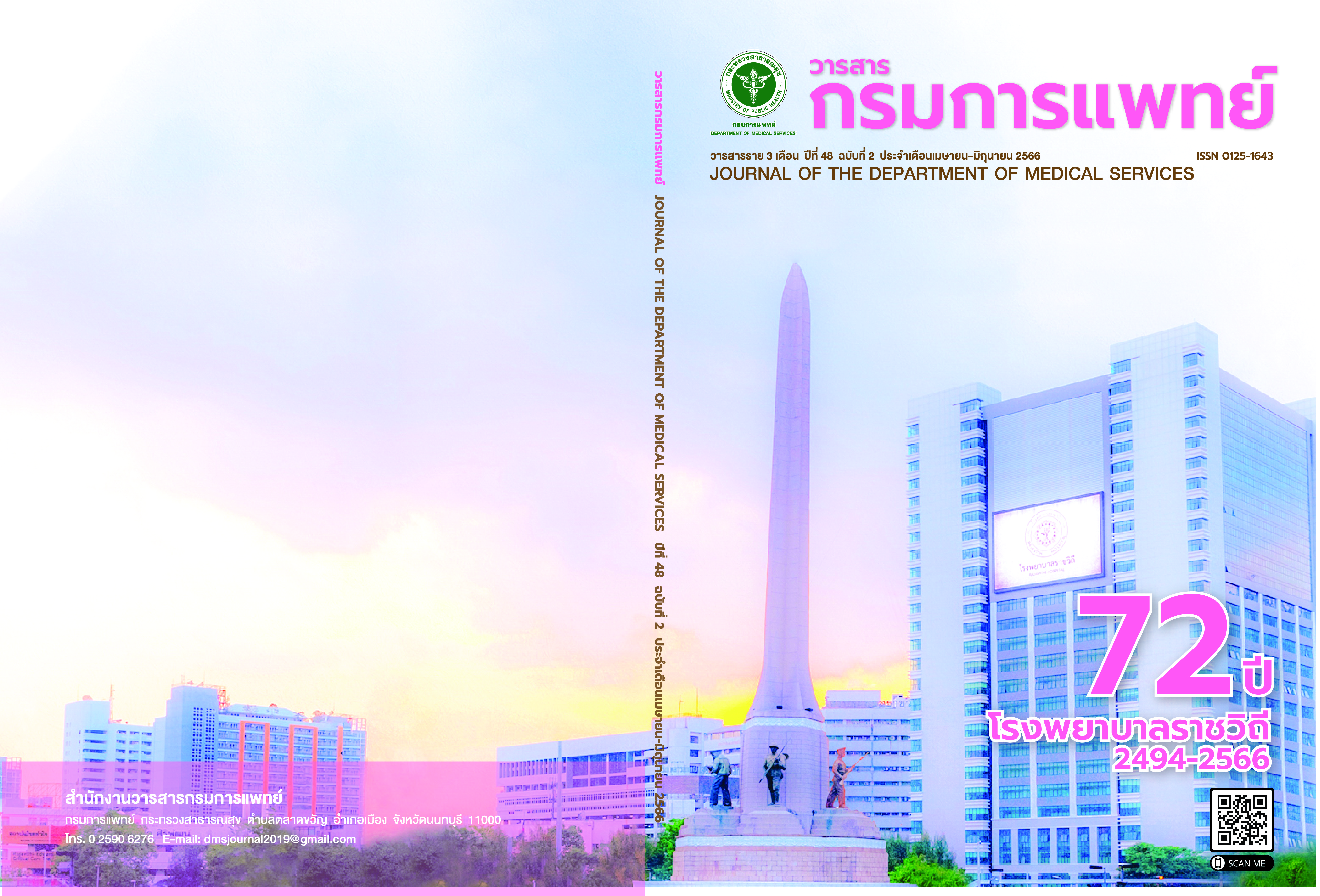Multiple Familial Glomangioma: A Case Report
DOI:
https://doi.org/10.14456/jdms.2023.33Keywords:
Glomuvenous malformations, Glomangiomas, Venous malformationsAbstract
Glomuvenous malformations (GVMs), also known as glomangiomas, are benign localized tumors of the skin, that often appear during infancy and childhood. Diagnosis of glomangiomas is based on clinical and histological features. This was a report of a 31-year-old woman who presented with violaceous plaques on the right upper chest since birth. New lesions continued to develop on the other sites including the right shoulder, right arm, right palm and right leg. Her brother had similar lesions on his left thigh. Incisional biopsy showed multiple dilated cavernous-like, thin-walled vascular spaces surrounded by multiple layers of glomus cells and red blood cells in the lumen. Her clinical and histological features were consistent with the diagnosis of multiple familial glomangioma. The treatment was not required for asymptomatic glomangiomas but the larger and extensive glomangiomas could be treated with laser therapy or sclerotherapy. This patient was treated with Nd: YAG (Excel V) for a reduction in glomangioma size.
References
Jha A, Ramesh V, Singh A. Disseminated cutaneousglomuvenous malformation. Indian J Dermatol VenereolLeprol 2014; 80(6):556-8.
Abbas A, Braswell M, Bernieh A, Brodell RT. Glomuvenousmalformations in a young man. Dermatol Online J 2018;24(10):11.
Myers RS, Lo AKM, Pawel BR. The glomangioma in thedifferential diagnosis of vascular malformations. Ann PlastSurg 2006; 57(4):443–6.
Blume-Peytavi U, Adler YD, Geilen CC, Ahmad W, Christiano A,Goerdt S, et al. Multiple familial cutaneous glomangioma: apedigree of 4 generations and critical analysis of histologic andgenetic differences of glomus tumors. J Am Acad Dermatol2000; 42(4):633–9.
Brouillard P, Ghassibé M, Penington A, Boon LM, Dompmartin A,Temple IK, et al. Four common glomulin mutations cause twothirds of glomuvenous malformations (“familial glomangiomas”): evidence for a founder effect. J Med Genet 2005; 42(2):13.
Mounayer C, Wassef M, Enjolras O, Boukobza M, Mulliken JB.Facial “glomangiomas”: large facial venous malformations withglomus cells. J Am Acad Dermatol 2001; 45(2):239–45.
Cabral CR, Oliveira Filho Jd, Matsumoto JL, Cignachi S,Tebet AC, Nasser Kda R. Type 2 segmental glomangioma--Casereport. An Bras Dermatol 2015; 90(3 sappl 1) :97-100.
Hughes R, Lacour J-P, Chiaverini C, Rogopoulos A, Passeron T.Nd:YAG laser treatment for multiple cutaneous glomangiomas:report of 3 cases. Arch Dermatol 2011; 147(2):255–6.
Calvert JT, Burns S, Riney TJ, Sahoo T, Orlow SJ, Nevin NC,et al. Additional glomangioma families link to chromosome1p: no evidence for genetic heterogeneity. Hum Hered 2001;51(3):180–2.
Dérand P 3rd, Warfvinge G, Thor A. Glomangioma: a casepresentation. J Oral Maxillofac Surg 2010; 68(1):204-7.
de la Fuente S, Hernández-Martín A, Happle R, Torrelo A. Type2 mosaicism in familial glomangiomatosis. Actas Dermosifliogr2014; 105(5):524–5.
Boon LM, Mulliken JB, Enjolras O, Vikkula M. Glomuvenousmalformation (glomangioma) and venous malformation: distinctclinicopathologic and genetic entities: Distinct clinicopathologicand genetic entities. Arch Dermatol 2004; 140(8):971–6.
Parsi K, Kossard S. Multiple hereditary glomangiomas:successful treatment with sclerotherapy. Australas J Dermatol2002; 43(7):43–7.
Shah A, Tassavor M, Sharma S, Tassavor B, Torbeck R. Surgicaland non-surgical treatment modalities for glomuvenousmalformations. Dermatol Online J 2021; 27(7):18.
Downloads
Published
How to Cite
Issue
Section
License
Copyright (c) 2023 Department of Medical Services, Ministry of Public Health

This work is licensed under a Creative Commons Attribution-NonCommercial-NoDerivatives 4.0 International License.
บทความที่ได้รับการตีพิมพ์เป็นลิขสิทธิ์ของกรมการแพทย์ กระทรวงสาธารณสุข
ข้อความและข้อคิดเห็นต่างๆ เป็นของผู้เขียนบทความ ไม่ใช่ความเห็นของกองบรรณาธิการหรือของวารสารกรมการแพทย์



